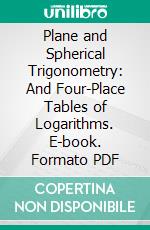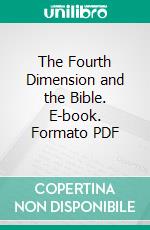Anthony William eBooks
eBooks di Anthony William di Formato Pdf
Plane and Spherical Trigonometry: And Four-Place Tables of Logarithms. E-book. Formato PDF William Anthony Granville - Forgotten Books, 2017 -
It has been the author's aim to treat the subject according to the latest and most approved methods. The book is designed for the use of colleges, technical schools, normal schools, secondary schools, and for those who take up the subject without the aid of a teacher. Special attention has been paid to the requirements of the College Entrance Board. The book contains more material than is required for some first courses in Trigonometry, but the matter has been so arranged that the teacher can make such omissions as will suit his particular needs. The trigonometric functions are defined as ratios; first for acute angles in right triangles, and then these definitions are extended to angles in general by means of coordinates. The student is first taught to use the natural functions of acute angles in the solution of simple problems involving right triangles. Attention is called to the methods shown in 23 — 29 for the reduction of functions of angles outside of the first quadrant. In general, the first examples given under each topic are worked out, making use of the natural functions. A large number of carefully graded exercises are given, and the processes involved are summarized into working rules wherever practicable. Illustrative examples are worked out in detail under each topic.
The Fourth Dimension and the Bible. E-book. Formato PDF William Anthony Granville - Forgotten Books, 2017 -
Pure mathematics is the vanguard of all the sciences, it has marched centuries in advance of them all. For instance, Calculus was discovered nearly two hundred years before the science of Chemistry was far enough advanced to allow the use of Calculus as. One of its instruments of re search. Practically the same thing is true of all the other physical sciences, including engineering. It may he, therefore, that the science of theology is not yet far enough advanced to admit of the ready use of mathematics as an instrument of research. Today mathematicians are forging ahead into' realms of abstract thought and pure logic as never before; judging from. The past, some of the truths which they are revealing now may not be put to what we are pleased to call practical use for centuries to come.
Elements of the Differential, and Integral Calculus (Revised: Edition). E-book. Formato PDF William Anthony Granville - Forgotten Books, 2017 -
That teachers and students of the Calculus have shown such a generous appreciation of Granville's "Elements of the Differential and Integral Calculus" has been very gratifying to the author. In the last few years considerable progress has been made in the teaching of the elements of the Calculus, and in this revised edition of Granville's "Calculus" the latest and best methods are exhibited, - methods that have stood the test of actual classroom work. Those features of the first edition which contributed so much to its usefulness and popularity have been retained. The introductory matter has been cut down somewhat in order to get down to the real business of the Calculus sooner. As this is designed essentially for a drill book, the pedagogic principle that each result should be made intuitionally as well as analytically evident to the student has been kept constantly in mind. The object is not to teach the student to rely on his intuition, but, in some cases, to use this faculty in advance of analytical investigation. Graphical illustration has been drawn on very liberally.This Calculus is based on the method of limits and is divided into two main parts, - Differential Calculus and Integral Calculus. As special features, attention may be called to the effort to make perfectly clear the nature and extent of each new theorem, the large number of carefully graded exercises, and the summarizing into working rules of the methods of solving problems. In the Integral Calculus the notion of integration over a plane area has been much enlarged upon, and integration as the limit of a summation is constantly emphasized. The existence of the limit e has been assumed and its approximate value calculated from its graph. A large number of new examples have been added, both with and without answers. At the end of almost every chapter will be found a collection of miscellaneous examples.


